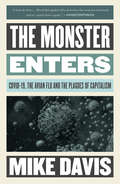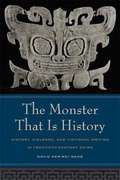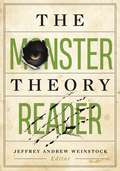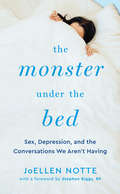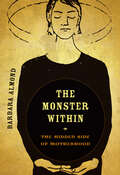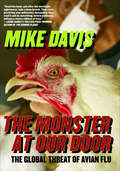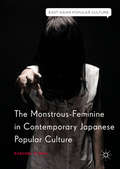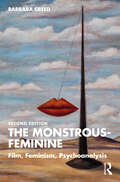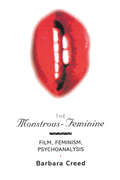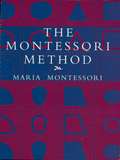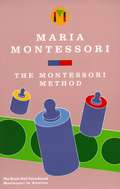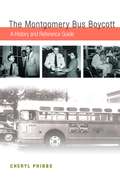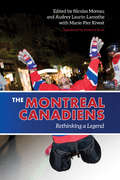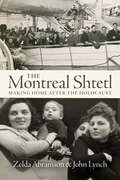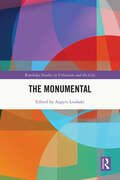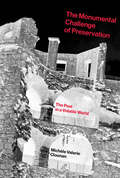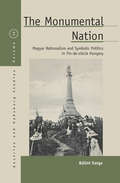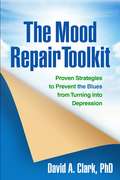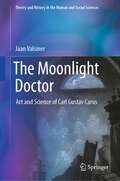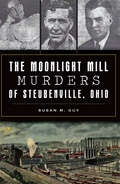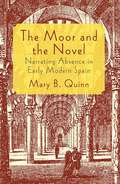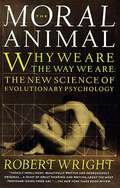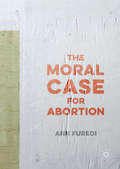- Table View
- List View
The Monster Enters: COVID-19, Avian Flu, and the Plagues of Capitalism
by Mike DavisA new edition of a classic book on viral catastrophes--the Spanish flu, the Avian flu, and now, Covid-19In his book, The Monster at Our Door, the renowned activist and author Mike Davis warned of a coming global threat of viral catastrophes. Now in this expanded edition of that 2005 book, Davis explains how the problems he warned of remain, and he sets the COVID-19 pandemic in the context of previous disastrous outbreaks, notably the 1918 influenza disaster that killed at least forty million people in three months and the Avian flu of a decade and a half ago.In language both accessible and authoritative, The Monster Enters surveys the scientific and political roots of today&’s viral apocalypse. In doing so it exposes the key roles of agribusiness and the fast-food industries, abetted by corrupt governments and a capitalist global system careening out of control, in creating the ecological pre-conditions for a plague that has brought much of human existence to a juddering halt.
The Monster That Is History: History, Violence, and Fictional Writing in Twentieth-century China
by David WangIn ancient China a monster called Taowu was known for both its vicious nature and its power to see the past and the future. Over the centuries Taowu underwent many incarnations until it became identifiable with history itself. Since the seventeenth century, fictive accounts of history have accommodated themselves to the monstrous nature of Taowu. Moving effortlessly across the entire twentieth-century literary landscape, David Der-wei Wang delineates the many meanings of Chinese violence and its literary manifestations. Taking into account the campaigns of violence and brutality that have rocked generations of Chinese--often in the name of enlightenment, rationality, and utopian plenitude--this book places its arguments along two related axes: history and representation, modernity and monstrosity. Wang considers modern Chinese history as a complex of geopolitical, ethnic, gendered, and personal articulations of bygone and ongoing events. His discussion ranges from the politics of decapitation to the poetics of suicide, and from the typology of hunger and starvation to the technology of crime and punishment.
The Monster Theory Reader
by Jeffrey Andrew WeinstockA collection of scholarship on monsters and their meaning—across genres, disciplines, methodologies, and time—from foundational texts to the most recent contributions Zombies and vampires, banshees and basilisks, demons and wendigos, goblins, gorgons, golems, and ghosts. From the mythical monstrous races of the ancient world to the murderous cyborgs of our day, monsters have haunted the human imagination, giving shape to the fears and desires of their time. And as long as there have been monsters, there have been attempts to make sense of them, to explain where they come from and what they mean. This book collects the best of what contemporary scholars have to say on the subject, in the process creating a map of the monstrous across the vast and complex terrain of the human psyche.Editor Jeffrey Andrew Weinstock prepares the way with a genealogy of monster theory, traveling from the earliest explanations of monsters through psychoanalysis, poststructuralism, and cultural studies, to the development of monster theory per se—and including Jeffrey Jerome Cohen&’s foundational essay &“Monster Theory (Seven Theses),&” reproduced here in its entirety. There follow sections devoted to the terminology and concepts used in talking about monstrosity; the relevance of race, religion, gender, class, sexuality, and physical appearance; the application of monster theory to contemporary cultural concerns such as ecology, religion, and terrorism; and finally the possibilities monsters present for envisioning a different future. Including the most interesting and important proponents of monster theory and its progenitors, from Sigmund Freud to Julia Kristeva to J. Halberstam, Donna Haraway, Barbara Creed, and Stephen T. Asma—as well as harder-to-find contributions such as Robin Wood&’s and Masahiro Mori&’s—this is the most extensive and comprehensive collection of scholarship on monsters and monstrosity across disciplines and methods ever to be assembled and will serve as an invaluable resource for students of the uncanny in all its guises.Contributors: Stephen T. Asma, Columbia College Chicago; Timothy K. Beal, Case Western Reserve U; Harry Benshoff, U of North Texas; Bettina Bildhauer, U of St. Andrews; Noel Carroll, The Graduate Center, CUNY; Jeffrey Jerome Cohen, Arizona State U; Barbara Creed, U of Melbourne; Michael Dylan Foster, UC Davis; Sigmund Freud; Elizabeth Grosz, Duke U; J. Halberstam, Columbia U; Donna Haraway, UC Santa Cruz; Julia Kristeva, Paris Diderot U; Anthony Lioi, The Julliard School; Patricia MacCormack, Anglia Ruskin U; Masahiro Mori; Annalee Newitz; Jasbir K. Puar, Rutgers U; Amit A. Rai, Queen Mary U of London; Margrit Shildrick, Stockholm U; Jon Stratton, U of South Australia; Erin Suzuki, UC San Diego; Robin Wood, York U; Alexa Wright, U of Westminster.
The Monster Under the Bed: Sex, Depression, and the Conversations We Aren't Having
by JoEllen NotteAlmost everyone has had some interaction with depression. Whether it's you, a family member, a friend, or a partner who is affected, depression has the potential to touch us all. Even so, many of us don't know how to handle depression becoming part of our love life and it can quickly become the monster under the bed. From "you have to love yourself first," to "don't stick it in the crazy," to dead silence, popular responses to the topic leave much to be desired. But you're not alone and you can have successful relationships and satisfying sex with depression. JoEllen Notte will help you understand how sexual function is affected by depression and what keeps us from effectively addressing it. Heavily informed by the author's research, including surveys of over 1,000 people and interviews with close to 200, this is the first book of its kind. With practical tips and real-life examples, this is both a guidebook for people with depression and the people who love them, as well as a reference tool for mental health professionals.
The Monster Within: The Hidden Side of Motherhood
by Barbara AlmondMixed feelings about motherhood—uncertainty over having a child, fears of pregnancy and childbirth, or negative thoughts about one’s own children—are not just hard to discuss, they are a powerful social taboo. In this beautifully written book, Barbara Almond brings this troubling issue to light. She uncovers the roots of ambivalence, tells how it manifests in lives of women and their children, and describes a spectrum of maternal behavior—from normal feelings to highly disturbed mothering. In a society where perfection in parenting is the unattainable ideal, this compassionate book also shows how women can affect positive change in their lives.
The Monster at Our Door: The Global Threat of Avian Flu
by Mike DavisThe MacArthur Fellow and author of Dead Cities presents a terrifying forecast of a new global threat—and &“its argument is irrefutable&” (The Independent). Hailed by The Nation as a &“master of disaster prose,&” author and activist Mike Davis addresses the imminent catastrophe of Avian influenza. In 1918, a pandemic strain of influenza killed at least forty million people in three months. Now, leading researchers believe, another global outbreak is all but inevitable. A virus of astonishing lethality, known as H5N1, has become entrenched in the poultry and wild bird populations of East Asia. It kills two out of every three people it infects. The World Health Organization warns that it is on the verge of mutating into a super-contagious pandemic form that could visit several billion homes within two years. In this urgent and alarming book, Mike Davis reconstructs the scientific and political history of a viral apocalypse in the making, exposing the central roles of agribusiness and the fast-food industries, abetted by corrupt governments, in creating the ecological conditions for the emergence of this new plague.
The Monstrous-Feminine in Contemporary Japanese Popular Culture (East Asian Popular Culture)
by Raechel DumasThis book explores the monstrous-feminine in Japanese popular culture, produced from the late years of the 1980s through to the new millennium. Raechel Dumas examines the role of female monsters in selected works of fiction, manga, film, and video games, offering a trans-genre, trans-media analysis of this enduring trope. The book focuses on several iterations of the monstrous-feminine in contemporary Japan: the self-replicating shōjo in horror, monstrous mothers in science fiction, female ghosts and suburban hauntings in cinema, female monsters and public violence in survival horror games, and the rebellious female body in mytho-fiction. Situating the titles examined here amid discourses of crisis that have materialized in contemporary Japan, Dumas illuminates the ambivalent pleasure of the monstrous-feminine as a trope that both articulates anxieties centered on shifting configurations of subjectivity and nationhood, and elaborates novel possibilities for identity negotiation and social formation in a period marked by dramatic change.
The Monstrous-Feminine: Film, Feminism, Psychoanalysis
by Barbara CreedThis is a timely update of a seminal text which re-interprets key films of the horror genre, including Carrie, The Exorcist, The Brood and Psycho. In the first edition, Creed draws on Julia Kristeva’s theory of abjection to challenge the popular view that women in horror are almost always victims, and argues that patriarchal ideology constructs women as monstrous in relation to her sexuality and reproductive body to justify her subjugation. Although a projection of male fears and paranoid fantasies, the monstrous-feminine is nonetheless a terrifying figure. Creed’s argument contests Freudian and Lacanian theories of sexual difference to offer a provocative rereading of classical and contemporary horror. This updated edition includes a new section examining contemporary feminist horror films in relation to nonhuman theory. Creed proposes a new concept of radical abjection to reinterpret the monstrous-feminine as a figure who embraces abjection by reclaiming her body and re-defining her otherness as nonhuman – while questioning patriarchy, anthropocentrism, misogyny and the meaning of the human. Films discussed include Ginger Snaps, Teeth, Atlantics, The Girl with All the Gifts, Border and Titane. Barbara Creed’s classic remains as relevant as ever and this edition will be of interest to academics and students of feminist theory, nonhuman theory, critical animal studies, race, and queer theory.
The Monstrous-Feminine: Film, Feminism, Psychoanalysis (Popular Fiction Ser.)
by Barbara CreedIn almost all critical writings on the horror film, woman is conceptualised only as victim. In The Monstrous-Feminine Barbara Creed challenges this patriarchal view by arguing that the prototype of all definitions of the monstrous is the female reproductive body.With close reference to a number of classic horror films including the Alien trilogy, T
The Montessori Method
by Maria MontessoriThis is, quite simply, one of the landmark books in the history of education. Written by influential Italian educator Maria Montessori (1870–1952), it describes a new system for educating young children based on materials and methods she originally developed to teach retarded students. The techniques proved highly effective with normal children as well. Her system, based on a radical conception of liberty for the pupil and a highly formal training of separate sensory, motor, and mental capacities, led to rapid and substantial mastery of reading, writing, and arithmetic. In The Montessori Method (1912), her first book, Dr. Montessori outlines her techniques in discussions of such topics as scientific pedagogy; discipline; diet; gymnastics; manual labor; education of the senses; methods for teaching reading, writing, and arithmetic; and many other topics. The Dover edition is the least expensive edition available, making this seminal classic widely accessible to teachers, principals, parents — anyone interested in the education of young children.
The Montessori Method: Scientific Pedagogy As Applied To Child Education In The Children's Houses
by Maria MontessoriThis book is Montessori's own exposition of the theory behind her innovative educational techniques. She shows parents, teachers and administrators how to "free a child to learn through his own efforts".
The Montgomery Bus Boycott: A History And Reference Guide
by Cheryl PhibbsThe Montgomery Bus Boycott: A History and Reference Guide offers a comprehensive account of a critical turning point in American history. The 1955–1956 bus boycott in Montgomery, Alabama, catapulted Martin Luther King, Jr., into the national spotlight and made Rosa Parks a household name. Far from the beginning of the Civil Rights Movement, it was the culmination of years of struggle, and a triumph of one Southern black community's determined non-violent protest against discrimination.
The Montreal Canadiens
by Nicolas Moreau Howard Scott Marie-Pier Rivest Audrey Laurin-LamotheOne of the most famous and certainly most successful professional hockey teams of all time, the Montreal Canadiens are practically a national institution in Quebec society. More than any other team, the Habs play an important role in the identity, economy, and culture of their home town and province.The essays in The Montreal Canadiens: Rethinking a Legend offer a panoramic view of this influence. What were the connections between the Maurice Richard Riot of 1955 and Quebec's Quiet Revolution? Can we say that loyalty to the team constitutes a religion for its fans? How is corporatization affecting how Quebecers connect with their beloved team? Featuring a wide range of writing on Le Grand Club and its social significance, the book offers a fresh and fascinating perspective on one of Canada's greatest sports teams.
The Montreal Shtetl: Making Home After the Holocaust
by John Lynch Zelda AbramsonAs the Holocaust is memorialized worldwide through education programs and commemoration days, the common perception is that after survivors arrived and settled in their new homes they continued on a successful journey from rags to riches. While this story is comforting, a closer look at the experience of Holocaust survivors in North America shows it to be untrue. The arrival of tens of thousands of Jewish refugees was palpable in the streets of Montreal and their impact on the existing Jewish community is well-recognized. But what do we really know about how survivors’ experienced their new community? Drawing on more than 60 interviews with survivors, hundreds of case files from Jewish Immigrant Aid Services, and other archival documents, The Montreal Shtetl presents a portrait of the daily struggles of Holocaust survivors who settled in Montreal, where they encountered difficulties with work, language, culture, health care, and a Jewish community that was not always welcoming to survivors. By reflecting on how institutional supports, gender, and community relationships shaped the survivors’ settlement experiences, Abramson and Lynch show the relevance of these stories to current state policies on refugee immigration.
The Monumental (Routledge Studies in Urbanism and the City)
by Argyro LoukakiThe Monumental is an interdisciplinary collection of original, cutting-edge contributions by international researchers pursuing the epistemology and ontology of monuments over time and geography. The contributors are specialists in geography, architectural theory and history, prehistoric, Greek and Roman archaeology, modern art, Byzantine studies, landscape theory, and heritage reception. Against the global climate of flux and uncertainty in the present turbulent world, the durability of monuments as “urban permanences” emerges as one of the few remaining spatial and mental anchorages. As such it is needed, maintained, enhanced, imitated, landscaped, and even invented. In particular, the monumental, a spatial and aesthetic phenomenon of perpetual importance, has recently acquired major new meanings. It now emerges as a key political, spatial, aesthetic, symbolic, architectural, and archaeological manifestation or entity, open to constantly new, even contradictory forms and expressions.This collection addresses the urgent need for relevant research on the monumental. It breaks new ground by posing fresh questions on the ontology, temporality, purpose, politics, scale, place, contestations, and aesthetics of and around the monumental, from prehistoric time to the present, as well as in both Eastern and Western geographies. Monuments are explored as bearers of the urban majestic, extraordinary and sublime. The Monumental poses questions about changing perceptions, the evocative power of representation, identity construction, ideology and symbolism, the vital necessity for a communicative and active public space around monuments, imitation processes across geographical space-time, as well as the powers that construct, deconstruct, or identify the monumental but also the anti-monumental as such. Geographies of reference are the European space, the United States, and Asia. Wide-ranging theorizations alternate with in-depth analyses of paradigmatic cases. Conventional as well as alternative forms of the monumental in the present shifting world are also pursued.The Monumental is of great value and interest to scholars, students, and professionals in the fields of architectural theory, history and design, archaeology, art theory and history, Byzantine studies, restoration, urban design and planning, human, urban and cultural geography, cultural studies, social anthropology, Asian studies, as well as those in wider subdisciplines.
The Monumental Challenge of Preservation: The Past in a Volatile World (The\mit Press Ser.)
by Michele Valerie CloonanThe enormous task of preserving the world's heritage in the face of war, natural disaster, vandalism, neglect, and technical obsolescence.The monuments—movable, immovable, tangible, and intangible—of the world's shared cultural heritage are at risk. War, terrorism, natural disaster, vandalism, and neglect make the work of preservation a greater challenge than it has been since World War II. In The Monumental Challenge of Preservation Michèle Cloonan makes the case that, at this critical juncture, we must consider preservation in the broadest possible contexts. Preservation requires the efforts of an increasing number of stakeholders.In order to explore the cultural, political, technological, economic, and ethical dimensions of preservation, Cloonan examines particular monuments and their preservation dilemmas. The massive Bamiyan Buddhas, blown up by the Taliban in 2001, are still the subject of debates over how, or whether, to preserve what remains, and the U. S. National Park Service has undertaken the complex task of preserving the symbolic and often ephemeral objects that visitors leave at the Vietnam Veterans Memorial—to take just two of the many examples described in the book. Cloonan also considers the ongoing genocide and cultural genocide in Syria; the challenges of preserving our digital heritage; the dynamic between original and copy; efforts to preserve the papers and architectural fragments of the architect Louis Sullivan; and the possibility of sustainable preservation. In the end, Cloonan suggests, we are what we preserve—and don't preserve. Every day we make preservation decisions, individually and collectively, that have longer-term ramifications than we might expect.
The Monumental Nation: Magyar Nationalism and Symbolic Politics in Fin-de-siecle Hungary (Austrian and Habsburg Studies #20)
by Bálint VargaFrom the 1860s onward, Habsburg Hungary attempted a massive project of cultural assimilation to impose a unified national identity on its diverse populations. In one of the more quixotic episodes in this "Magyarization," large monuments were erected near small towns commemorating the medieval conquest of the Carpathian Basin-supposedly, the moment when the Hungarian nation was born. This exactingly researched study recounts the troubled history of this plan, which-far from cultivating national pride-provoked resistance and even hostility among provincial Hungarians. Author Bálint Varga thus reframes the narrative of nineteenth-century nationalism, demonstrating the complex relationship between local and national memories.
The Mood Repair Toolkit
by David A. ClarkIf you have trouble bouncing back from low moods or just feel stuck in the doldrums much of the time, renowned cognitive behavior therapist David A. Clark has a clear message: there are simple yet powerful steps you can take to feel better. This encouraging book presents 80 strategies you can use to reduce sadness, promote positive feelings of contentment and joy, and decrease your risk for full-blown depression. Vivid stories and concrete examples help you learn specific methods for: *Nipping negativity in the bud. *Making unhappiness less overwhelming. *Defusing self-criticism and rumination. *Boosting your energy and motivation for change. *Feeling more confident and hopeful every day. Using the practical tools in the book--forms, worksheets, and self-assessment quizzes--makes it easy to create and stick to a mood repair action plan. You can download and print additional copies of these tools as needed. The strategies that Dr. Clark provides are grounded in cutting-edge neuroscience and psychology research--and they work. Discover proven ways to start living a more satisfying and productive life.
The Mood Repair Toolkit
by David A. ClarkIf you have trouble bouncing back from low moods or just feel stuck in the doldrums much of the time, renowned cognitive behavior therapist David A. Clark has a clear message: there are simple yet powerful steps you can take to feel better. This encouraging book presents 80 strategies you can use to reduce sadness, promote positive feelings of contentment and joy, and decrease your risk for full-blown depression. Vivid stories and concrete examples help you learn specific methods for: *Nipping negativity in the bud. *Making unhappiness less overwhelming. *Defusing self-criticism and rumination. *Boosting your energy and motivation for change. *Feeling more confident and hopeful every day. Using the practical tools in the book--forms, worksheets, and self-assessment quizzes--makes it easy to create and stick to a mood repair action plan. You can download and print additional copies of these tools as needed. The strategies that Dr. Clark provides are grounded in cutting-edge neuroscience and psychology research--and they work. Discover proven ways to start living a more satisfying and productive life.
The Moonlight Doctor: Art and Science of Carl Gustav Carus (Theory and History in the Human and Social Sciences)
by Jaan ValsinerThis is the very first authoritative book on the role of Carl Gustav Carus (1789-1869) in the history of psychology. Carus was the initiator of the notions of development, unconscious, and archetype in psychology. The book emphasizes the interdisciplinary focus of Carus’ work as it was based on the literature and art of his time and is closely related with medicine and Naturphilosophie. The readership of the book will get access to the life course of a key figure of science of the 19th century.
The Moonlight Mill Murders of Steubenville, Ohio (True Crime Ser.)
by Susan M Guy&“Guy is not only a historian but a longtime police officer in Ohio, bringing firsthand knowledge of the criminal justice system&” to the Phantom Killer tale (Crime Capsule). Prohibition ended on December 5, 1933, and Steubenville hoped that its reputation as &“Little Chicago&” would end with it. That hope was short-lived when, eight weeks later, the Phantom Killer made his midnight debut. Under the glow of a full moon, in the mill yards of Steubenville&’s Wheeling Steel Plant, the killer ambushed a rail worker, shooting him five times. The Steubenville Police Department, Jefferson County Sheriff&’s Department and Wheeling Steel Mill Police joined forces in the New Year to find the Phantom before he took another victim. The strongest of millworkers on the midnight shift began to arm themselves, wondering who would be next. As the investigation wore on, Steubenville was once again thrust into the national spotlight as the Phantom&’s reign of terror continued. Local historian Susan M. Guy delves into one of the city&’s most infamous crimes.
The Moor and the Novel
by Mary B. QuinnThis book reveals fundamental connections between nationalist violence, religious identity, and the origins of the novel in the early modern period. Through fresh interpretations of music, literature, and history it argues that the expulsion of the Muslim population created a historic and artistic aperture that was addressed in new literary forms.
The Moral Animal: Why We Are, the Way We Are: The New Science of Evolutionary Psychology
by Robert WrightAre men literally born to cheat? Does monogamy actually serve women's interests? These are among the questions that have made The Moral Animal one of the most provocative science books in recent years. Wright unveils the genetic strategies behind everything from our sexual preferences to our office politics--as well as their implications for our moral codes and public policies. Illustrations.From the Trade Paperback edition.
The Moral Case for Abortion
by Ann FurediThis thought-provoking book sets out the ethical arguments for a woman's right to choose. Drawing on the traditions of sociological thinking and moral philosophy, it maintains that there is a strong moral case for recognizing autonomy in personal decision-making about reproductive intentions. More than this, it argues that to prevent a woman from making her own choice to continue or end her pregnancy is to undermine the essence of her humanity. The author, a provider of abortion services in the UK, asserts that true respect for human life and true regard for individual conscience demand that we respect a woman's right to decide, and that support for a woman's right to a termination has moral foundations and ethical integrity. This fresh perspective on abortion will interest both pro- and anti-choice individuals and organizations, along with academics in the fields of gender studies, philosophy, ethics and religion.
The Moral Case for Abortion
by Ann FurediThis thought-provoking book sets out the ethical arguments for a woman’s right to choose. Drawing on the traditions of sociological thinking and moral philosophy, it maintains that there is a strong moral case for recognizing autonomy in personal decision-making about reproductive intentions. More than this, it argues that to prevent a woman from making her own choice to continue or end her pregnancy is to undermine the essence of her humanity. The author, a provider of abortion services in the UK, asserts that true respect for human life and true regard for individual conscience demand that we respect a woman’s right to decide, and that support for a woman’s right to a termination has moral foundations and ethical integrity. This fresh perspective on abortion will interest both pro- and anti-choice individuals and organizations, along with academics in the fields of gender studies, philosophy, ethics and religion.
